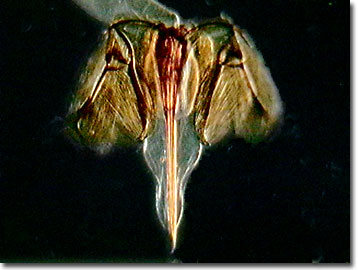Darkfield Digital Image Gallery
Honeybee Stinger
When former heavyweight champion boxer Muhammad Ali said he wanted to float like a butterfly, but sting like a bee, he probably had the honeybee on his mind. Unlike many other members of the order Hymenoptera, honeybees usually do not sting unless provoked.

The honeybee's stinger is smaller than the head of a pin, but its venom can produce pain worse than a hypodermic needle. The consequences of a bee sting are even more severe for two percent of the human population who are allergic to bee venom, and can suffer swelling, rash, dizziness, and even anaphylactic shock. Twin lancets attached to a stylet are pulled into the flesh by barbs positioned along the sides of the stinger.
The stinger (or aculeus) is located on female worker bees at the posterior end of the abdomen and is part of the ovipositor, which is an egg-laying device. Even though most bees can sting repeatedly, the honeybee, the kamikaze of the insect world, only has one chance. The honeybee stinger has a hook-shaped barb and when it catches in a victim the bee can't fly away without self-inflicting a fatal wound by tearing out its ovipositor along with some internal organs. Even after the bee detaches itself, the venom sac and its attached striated muscles continue to pump venom into the victim through the injected stinger shaft.
Most researchers believe the honeybee originated in Africa and the first European colonists introduced the common honeybee, Apis mellifera to the New World. Native Americans referred to the foreign bees as the "white man's fly". Now, honeybees are found worldwide. Concerns about bee stings recently entered the public health arena with the spread of killer bees throughout South and North America. In 1956, wild African bees were imported into Brazil for breeding experiments to improve honey production, but some escaped in 1957 and mated with previously imported European honeybees. The Africanized honeybees established themselves as a particularly aggressive breed and soon earned themselves the name "killer bees." Swarms of Africanized honeybees have been known to kill small and large farm animals as well as humans. While their venom is no more potent than that of the European honeybee, the Africanized honeybees react more quickly to a threat, attack in greater numbers, pursue for a longer time, and take longer (as long as 24 hours) to calm down. Africanized honeybees have been spreading north over the decades, through Argentina and northward throughout South and Central America, and into Mexico. They first entered the United States in Southern Texas in 1990. Since then, colonies have been found in California, New Mexico, Nevada, Arizona, Florida, Alabama, and Virginia.
Contributing Authors
Cynthia D. Kelly, Thomas J. Fellers and Michael W. Davidson - National High Magnetic Field Laboratory, 1800 East Paul Dirac Dr., The Florida State University, Tallahassee, Florida, 32310.
BACK TO THE DARKFIELD IMAGE GALLERY
BACK TO THE DIGITAL IMAGE GALLERIES
Questions or comments? Send us an email.
© 1995-2025 by Michael W. Davidson and The Florida State University. All Rights Reserved. No images, graphics, software, scripts, or applets may be reproduced or used in any manner without permission from the copyright holders. Use of this website means you agree to all of the Legal Terms and Conditions set forth by the owners.
This website is maintained by our
Graphics & Web Programming Team
in collaboration with Optical Microscopy at the
National High Magnetic Field Laboratory.
Last Modification Friday, Nov 13, 2015 at 01:19 PM
Access Count Since September 17, 2002: 16034
Visit the website of our partner in introductory microscopy education:
|
|
